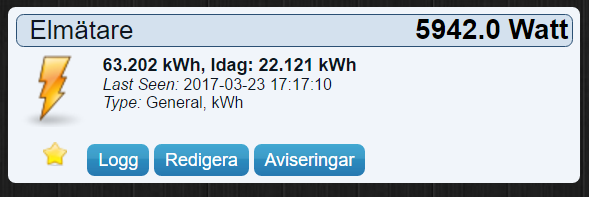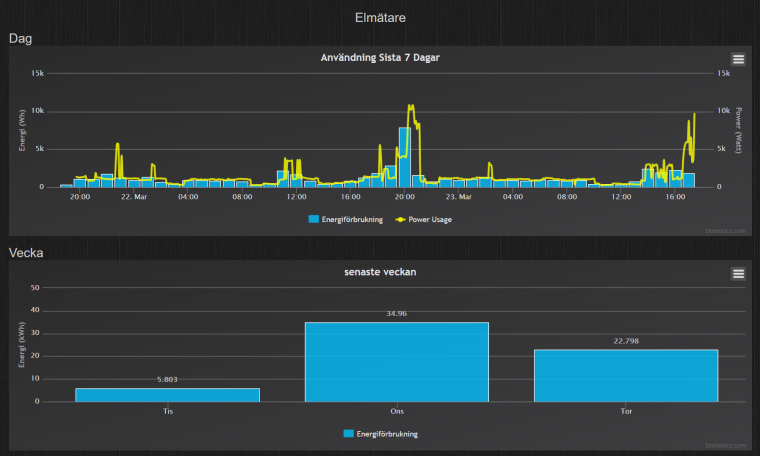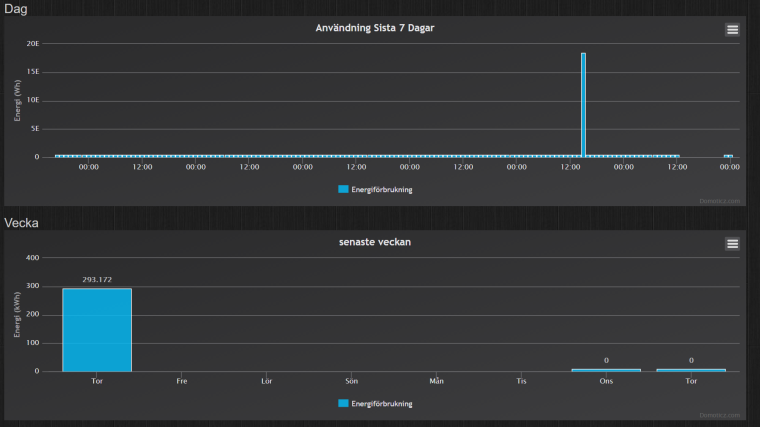💬 Power Meter Pulse Sensor
-
Hello,
I don't understand why, but my power meter sensor gives a higher index than the real power meter index after 2 days.
I think that it counts more pulses than pulses provided by the power meter...
Does anybody encounter this problem ?
Can it be cause to bounce for example ?Thank you
@moumout31
I had same issue, check here for my solution
https://forum.mysensors.org/topic/4716/two-energy-meter/4 -
@moumout31
could it be getting some light from another source?@gohan No, the light is always switched off in this room and I tried, when I switch on the light, there is no pulse from the sensor.
@flopp Thanks for your help. What I see in your topic is that you increase from 10000µs to 40000µs the interval to avoid corrupted interrupts, is that correct ?
Thank you
-
@gohan No, the light is always switched off in this room and I tried, when I switch on the light, there is no pulse from the sensor.
@flopp Thanks for your help. What I see in your topic is that you increase from 10000µs to 40000µs the interval to avoid corrupted interrupts, is that correct ?
Thank you
@moumout31
Yes correct.
When I checked with Serial Monitor and some serial.print in different places I could see that arduino registered double interrupts -
@moumout31
Yes correct.
When I checked with Serial Monitor and some serial.print in different places I could see that arduino registered double interrupts -
@moumout31
Yes correct.
When I checked with Serial Monitor and some serial.print in different places I could see that arduino registered double interrupts -
@moumout31
Yes correct.
When I checked with Serial Monitor and some serial.print in different places I could see that arduino registered double interrupts@flopp After a few days, I confirm you that the index is consistent with power meter index.
However, instant power in watt is not correcly calculated.
For example, when power meter indicates 550W, about 1500W is calculated by the sketch. Do you know how I can resolve this problem please ?Thanks a lot !
-
@flopp After a few days, I confirm you that the index is consistent with power meter index.
However, instant power in watt is not correcly calculated.
For example, when power meter indicates 550W, about 1500W is calculated by the sketch. Do you know how I can resolve this problem please ?Thanks a lot !
@moumout31
Watt calculation is using time between two interrupts.
How often do you send watt?
Did you measure watt with a measurement tool How did you get 500 watts from power meter?
When you send watt you need to measure exact same second otherwise it will not be correct. -
@moumout31
Watt calculation is using time between two interrupts.
How often do you send watt?
Did you measure watt with a measurement tool How did you get 500 watts from power meter?
When you send watt you need to measure exact same second otherwise it will not be correct. -
Just changed from 1-wire counter to MySensors for logging my power consumption. Using the same LED detector as I did when using 1-wire. Also changed watt limit to 20 000 (my heat pump likes to use 9-10kW sometimes). The wires from the old 1-wire net now provide power for the new MySensors-sensor. I have 10 000 led blinks per kWh. Had som crazy counter values with 1-wire that totally messed up the graphs and haven't seen anything like that with this sketch. Let's hope it stays that way. ;) Dumping data to Domoticz. This sensor gives me higher resolution as a bonus. The 1-wire counter was read every minute, this every 20-sec. ;-)


My old 1-wire counter with one crazy value messing upp all the graphs:

I know that you can hold shift and click the value that is crazy to make the graphs show up good but you loose the data for the full day. That's not good. ;-) -
I seem to be getting a connection to my gateway, while monitoring the two topics for the gateway i only seem to see any activity regarding this sensor on the gateway-out topic, and it keeps sending out a type 2 message (req). The serial monitor of the sensors is showing:
104198 TSF:MSG:SEND,16-16-0-0,s=1,c=2,t=24,pt=0,l=0,sg=0,ft=0,st=OK:
114199 TSF:MSG:SEND,16-16-0-0,s=1,c=2,t=24,pt=0,l=0,sg=0,ft=0,st=OK:
124200 TSF:MSG:SEND,16-16-0-0,s=1,c=2,t=24,pt=0,l=0,sg=0,ft=0,st=OK:
134201 TSF:MSG:SEND,16-16-0-0,s=1,c=2,t=24,pt=0,l=0,sg=0,ft=0,st=OK:
144202 TSF:MSG:SEND,16-16-0-0,s=1,c=2,t=24,pt=0,l=0,sg=0,ft=0,st=OK:
154203 TSF:MSG:SEND,16-16-0-0,s=1,c=2,t=24,pt=0,l=0,sg=0,ft=0,st=OK:
164204 TSF:MSG:SEND,16-16-0-0,s=1,c=2,t=24,pt=0,l=0,sg=0,ft=0,st=OK:
174205 TSF:MSG:SEND,16-16-0-0,s=1,c=2,t=24,pt=0,l=0,sg=0,ft=0,st=OK:
184206 TSF:MSG:SEND,16-16-0-0,s=1,c=2,t=24,pt=0,l=0,sg=0,ft=0,st=OK:
194207 TSF:MSG:SEND,16-16-0-0,s=1,c=2,t=24,pt=0,l=0,sg=0,ft=0,st=OK:So it seems to be sending a request package, but i don't see it on the gateway-in topic and i see other sensors sending data to the gateway-in topic so i'm not subscribed to the wrong one. Is this a structural request message or is this the feature that requests the last known message from the gateway? Either way, there doesn't seem to be any sensor data being sent from the node to the gateway.
-
I seem to be getting a connection to my gateway, while monitoring the two topics for the gateway i only seem to see any activity regarding this sensor on the gateway-out topic, and it keeps sending out a type 2 message (req). The serial monitor of the sensors is showing:
104198 TSF:MSG:SEND,16-16-0-0,s=1,c=2,t=24,pt=0,l=0,sg=0,ft=0,st=OK:
114199 TSF:MSG:SEND,16-16-0-0,s=1,c=2,t=24,pt=0,l=0,sg=0,ft=0,st=OK:
124200 TSF:MSG:SEND,16-16-0-0,s=1,c=2,t=24,pt=0,l=0,sg=0,ft=0,st=OK:
134201 TSF:MSG:SEND,16-16-0-0,s=1,c=2,t=24,pt=0,l=0,sg=0,ft=0,st=OK:
144202 TSF:MSG:SEND,16-16-0-0,s=1,c=2,t=24,pt=0,l=0,sg=0,ft=0,st=OK:
154203 TSF:MSG:SEND,16-16-0-0,s=1,c=2,t=24,pt=0,l=0,sg=0,ft=0,st=OK:
164204 TSF:MSG:SEND,16-16-0-0,s=1,c=2,t=24,pt=0,l=0,sg=0,ft=0,st=OK:
174205 TSF:MSG:SEND,16-16-0-0,s=1,c=2,t=24,pt=0,l=0,sg=0,ft=0,st=OK:
184206 TSF:MSG:SEND,16-16-0-0,s=1,c=2,t=24,pt=0,l=0,sg=0,ft=0,st=OK:
194207 TSF:MSG:SEND,16-16-0-0,s=1,c=2,t=24,pt=0,l=0,sg=0,ft=0,st=OK:So it seems to be sending a request package, but i don't see it on the gateway-in topic and i see other sensors sending data to the gateway-in topic so i'm not subscribed to the wrong one. Is this a structural request message or is this the feature that requests the last known message from the gateway? Either way, there doesn't seem to be any sensor data being sent from the node to the gateway.
@Samuel235 said in 💬 Power Meter Pulse Sensor:
164204 TSF:MSG:SEND,16-16-0-0,s=1,c=2,t=24,pt=0,l=0,sg=0,ft=0,st=OK:
I dont know if I dont understand you, but it seems like your node is requesting the last pulse counter. I have mentioned this in several threads I have a problem with this (both this thread and rain sensor thread). Im using an ethernet gw and the request reaches the gw but there my error led blinks and it fails to send it back (or recieve it on the node) so it re-request it.
I have never been able to pinpoint it due to repeaters in between.
https://forum.mysensors.org/topic/2116/hard-to-grab-time-and-value-sent-from-controller/ (old). -
@Samuel235 said in 💬 Power Meter Pulse Sensor:
164204 TSF:MSG:SEND,16-16-0-0,s=1,c=2,t=24,pt=0,l=0,sg=0,ft=0,st=OK:
I dont know if I dont understand you, but it seems like your node is requesting the last pulse counter. I have mentioned this in several threads I have a problem with this (both this thread and rain sensor thread). Im using an ethernet gw and the request reaches the gw but there my error led blinks and it fails to send it back (or recieve it on the node) so it re-request it.
I have never been able to pinpoint it due to repeaters in between.
https://forum.mysensors.org/topic/2116/hard-to-grab-time-and-value-sent-from-controller/ (old).@sundberg84 - You do understand me correctly :). I made a thread on the troubleshooting section of the forum for this simply because i suspected it was normal behaviour, however. It seems that the node isn't sending any other data to the gateway at all and it can not get the previous value as there isn't one. So, my post here and on the troubleshooting section was me aiming to get to this point and then troubleshoot the actual node to see what can be done to get it to send data.
-
Has anyone came across their pulse meter not sending the message for WATT, the other two messages are being sent perfectly fine. My WATT message has been working all day and suddenly stopped.
-
@NiklasO - Where is this value stored? I've cleared the EEPROM and the MQTT topic too, but it still refuses to send the watt value.
@Samuel235
In the sketch, change this
#define MAX_WATT 10000 // Max watt value to report. This filetrs outliers.
I have it set to 20000, using 15 000 easily when it's cold outside. ;-) Just make sure that you use the right divider for your pulse/kWh count. -
@Samuel235
In the sketch, change this
#define MAX_WATT 10000 // Max watt value to report. This filetrs outliers.
I have it set to 20000, using 15 000 easily when it's cold outside. ;-) Just make sure that you use the right divider for your pulse/kWh count.Ahh i see what it is it; its set to not send if it hasn't changed.... how much of a silly error that was from me. The wattage is way below 1000 but because i'm using a normal LED on another arduino flashing at a constant rate to set my node up, its not changing the watt value.
Back to solving my initial issue now >.<
Thank you.
